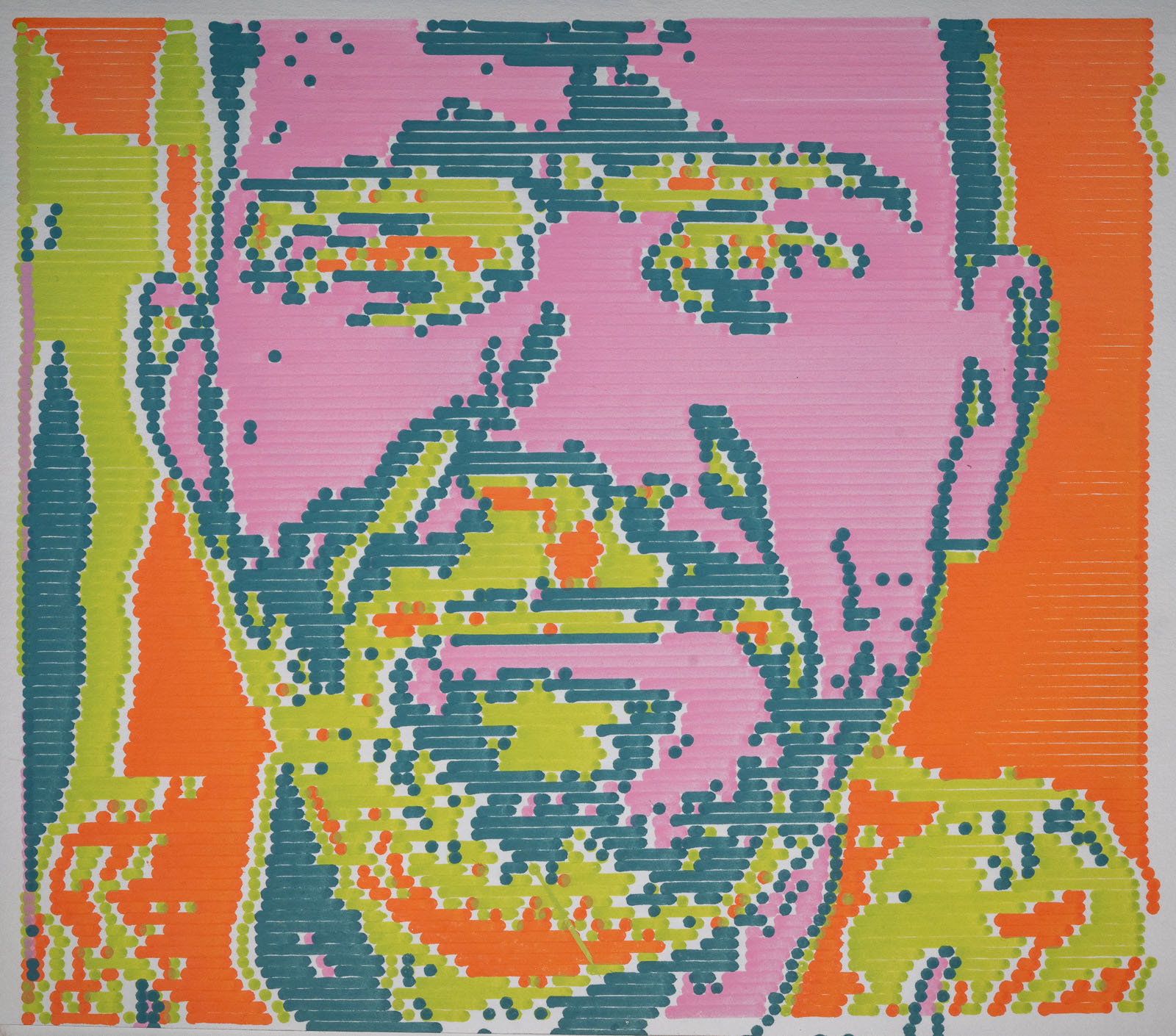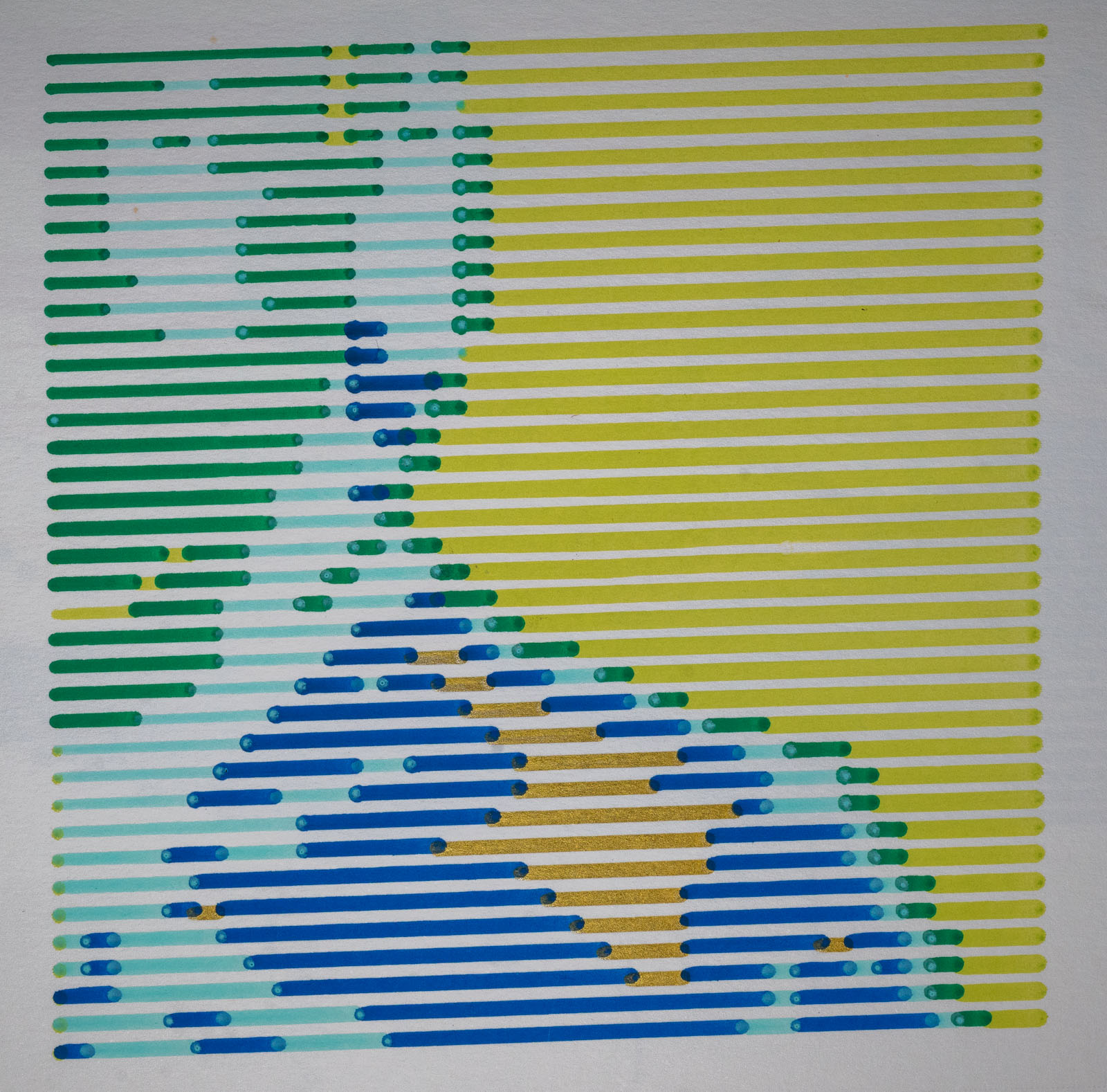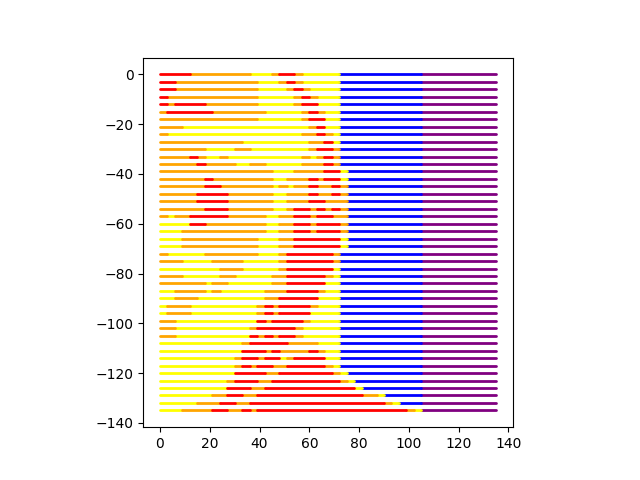2023-11-15 Image Lines
Description
Convert an image into a series of parallel lines where each line is one of N colors.
Images


Plotter Preview

Code
from gcode2dplotterart import Plotter2D
import cv2
import numpy as np
from imutils import resize
from math import floor
from typing import List
"""
Preface - numpy and cv2 are still a bit alien to me. The code here could be done better.
1. Take in an image.
2. Grayscale all of the pixels so that each pixel is represented by a number from 0 to 255.
3. Bucket the pixels such that
- 0 -> A becomes 0
- A -> B becomes 1
- B -> C becomes 2
- C -> 255 becomes 3
4. Start with the first row of pixels.
5. Add the first point to a new path and move to the next pixel.
6. If the current pixel is the same as the previous pixel, append the point to the path and repeat, otherwise,
start a new path.
7. Continue until all points of all colors are plotted.
Note
- Make sure that the combination of X_SCALE, Y_SCALE, and the resized image aren't too big for the plotter area.
"""
# These numbers can be changed in combination with the image size. Adds a bit of spacing since I use thicker
# pens and they'd overlap.
X_PIXELS_PER_PLOTTER_UNIT = 1 / 3
Y_PIXELS_PER_PLOTTER_UNIT = 1 / 3
def evenly_distribute_pixels_per_color(
img: cv2.typing.MatLike, n: int
) -> List[List[int]]:
"""
Ensures that each color has the same number of pixels.
Arg:
`img` : cv2.typing.MatLike
The image to process
`n` : Number of colors to distribute pixels into
Returns
` img` : List[List[int]]
Image mapped to n colors
"""
total_pixels = img.size
pixel_bins = []
histogram, bins = np.histogram(img.ravel(), 256, (0, 256))
count = 0
for pixel_value, pixel_count in enumerate(histogram):
if count >= total_pixels / (n):
count = 0
pixel_bins.append(pixel_value)
count += pixel_count
return np.subtract(np.digitize(img, pixel_bins), 0)
def resize_image_for_plotter(filename: str) -> List[List[int]]:
img = cv2.imread(filename)
img = cv2.cvtColor(img, cv2.COLOR_BGR2GRAY)
# The following math will ensure that the image is scaled to the plotter size and the remaining math
# throughout the program will work.
plotter_ratio = "landscape" if plotter.width > plotter.height else "portrait"
# It appears shape is (columns, rows)
img_ratio = "landscape" if img.shape[1] > img.shape[0] else "portrait"
if (
plotter_ratio == "landscape"
and img_ratio == "landscape"
or plotter_ratio == "portrait"
and img_ratio == "landscape"
):
img = resize(img, width=floor(plotter.width * X_PIXELS_PER_PLOTTER_UNIT))
elif (
plotter_ratio == "portrait"
and img_ratio == "portrait"
or plotter_ratio == "landscape"
and img_ratio == "portrait"
):
print("resizing height")
img = resize(img, height=floor(plotter.height * Y_PIXELS_PER_PLOTTER_UNIT))
print("resized to ", img.shape)
return img
plotter = Plotter2D(
title="Horizontal Line Art",
x_min=0,
x_max=200,
y_min=-140, # Note - My plotting goes from -150 to 0.
y_max=0,
feed_rate=10000,
output_directory="./output",
handle_out_of_bounds="Warning", # It appears that some points end up outside of bounds so scale down.
)
COLOR_LAYERS = [
"purple",
"blue",
"yellow",
"orange",
"red",
]
for layer in COLOR_LAYERS:
plotter.add_layer(layer, color=layer)
input_filename = "landscape.jpg"
# Works with color PNGs exported from Lightroom and Photoshop. Could learn some more about reading images
resized_image = resize_image_for_plotter(input_filename)
color_reduced_image = evenly_distribute_pixels_per_color(
resized_image, n=len(COLOR_LAYERS)
)
for y_index, row in enumerate(color_reduced_image):
y_plotter_scale = (
y_index / Y_PIXELS_PER_PLOTTER_UNIT * -1
) # My plotter goes y=-150 to y=0, therefore numbers are negative. Probably a better solution.
line_start = [0, y_plotter_scale]
line_end = None
current_color_value = color_reduced_image[0][y_index]
for x_index, color_value in enumerate(row):
x_plotter_scale = x_index / X_PIXELS_PER_PLOTTER_UNIT
if color_value == current_color_value:
continue
line_end = [x_plotter_scale, y_plotter_scale]
plotter.layers[COLOR_LAYERS[current_color_value]].add_line(
line_start[0], line_start[1], line_end[0], line_end[1]
)
line_start = line_end
current_color_value = color_value
line_end = [x_plotter_scale, y_plotter_scale]
plotter.layers[COLOR_LAYERS[current_color_value]].add_line(
line_start[0], line_start[1], line_end[0], line_end[1]
)
plotter.preview()
plotter.save()